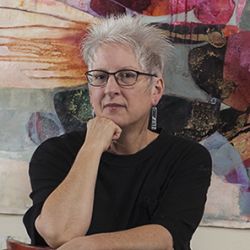Anna Carll was born in 1960 in Charleston, WV, into a large German-American family with five other siblings. Raised in Sarasota, FL, Carll’s early influences were imprinted in a tropical and urban setting. In 1984, Carll received her BA from the University of Florida, after which she emigrated to Atlanta, GA, where she lived and worked for 16 years. After Carll embraced the fine art discipline she spent 12 years honing her craft in the North Georgia Mountains under the influence of the beautiful Appalachians in the Blue Ridge area. Carll now makes her home in Chattanooga, TN.
Carll began her career as an illustrator and graphic designer, with a strong background in art history. During her career as a designer in Atlanta, Carll freelanced with the Trousdell Design Studio on the Bally’s Casino Hotel’s account and her independent clients included: Coca-Cola, Georgia Pacific, Canada Life Insurance and Southwire. In 1992, Carll began private study with the late painter Ouida Canaday who founded the Artists’ Atelier of Atlanta and was co-founder of the Atlanta Piedmont Arts Festival. Canaday was a contemporary of the Atlanta artist, Joe Perrin. In 1999, Carll quit the graphic design industry to become a full-time painter. From that point onward she evolved as a self-taught artist. Carll’s main influences are Picasso, Matisse, Gerhard Richter & Pat Steir.
Carll’s abstract work is based on the concept of erosion and utilizes a lot of the techniques that she first developed with her colorful figurative work. When Carll first introduced her abstract work she did so under the pseudonym Marie Lauer. This was deliberate in that the new work was so radically different that Carll felt the need to introduce it under a new persona. Carll appears in both New American Paintings and Studio Visit as Marie Lauer. Carll has since dropped the ghost name and has embraced all sides of her work.
Carll’s first gallery representation began in 1997 with Bender Fine Art Gallery in Atlanta and is now represented by several galleries in the United States. Carll’s work is collected by a diverse group of corporations and patrons in the United States, South America, Europe and Asia.
